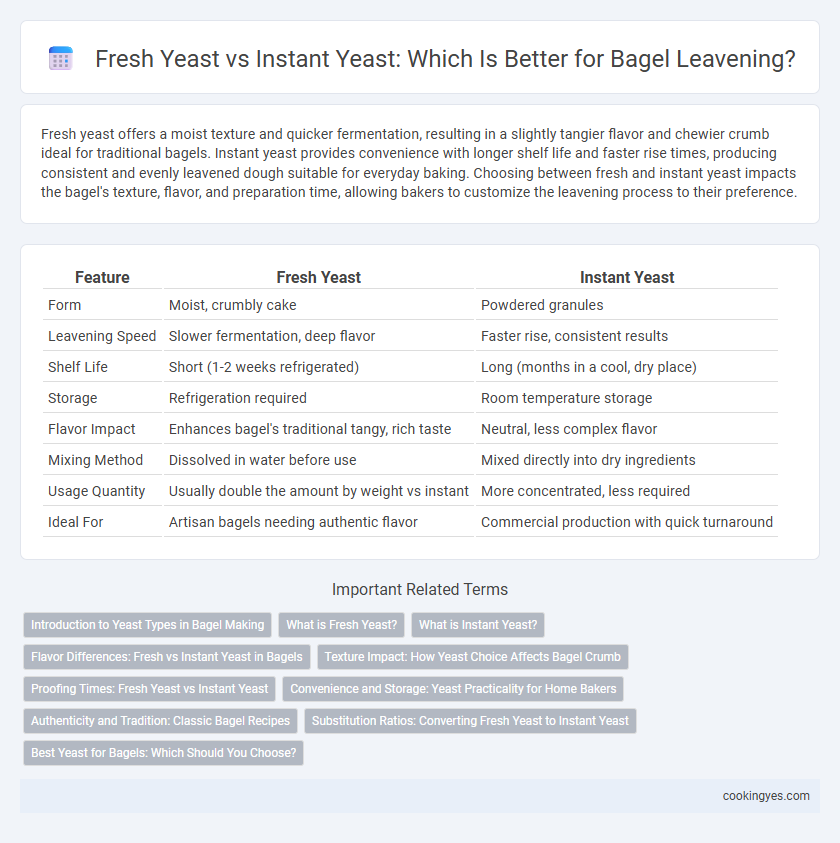Fresh yeast offers a moist texture and quicker fermentation, resulting in a slightly tangier flavor and chewier crumb ideal for traditional bagels. Instant yeast provides convenience with longer shelf life and faster rise times, producing consistent and evenly leavened dough suitable for everyday baking. Choosing between fresh and instant yeast impacts the bagel's texture, flavor, and preparation time, allowing bakers to customize the leavening process to their preference.
Table of Comparison
| Feature | Fresh Yeast | Instant Yeast |
|---|---|---|
| Form | Moist, crumbly cake | Powdered granules |
| Leavening Speed | Slower fermentation, deep flavor | Faster rise, consistent results |
| Shelf Life | Short (1-2 weeks refrigerated) | Long (months in a cool, dry place) |
| Storage | Refrigeration required | Room temperature storage |
| Flavor Impact | Enhances bagel's traditional tangy, rich taste | Neutral, less complex flavor |
| Mixing Method | Dissolved in water before use | Mixed directly into dry ingredients |
| Usage Quantity | Usually double the amount by weight vs instant | More concentrated, less required |
| Ideal For | Artisan bagels needing authentic flavor | Commercial production with quick turnaround |
Introduction to Yeast Types in Bagel Making
Fresh yeast, known for its high moisture content and short shelf life, provides a subtle, natural fermentation ideal for traditional bagel textures. Instant yeast, a dried and granulated form, offers faster activation and longer storage, making it a convenient option for consistent dough rising. Both yeast types influence the bagel's crumb structure and flavor development through their fermentation properties.
What is Fresh Yeast?
Fresh yeast, also known as cake yeast or compressed yeast, is a moist, perishable form of yeast commonly used in traditional bagel recipes for its strong leavening power and distinctive flavor profile. It contains live yeast cells suspended in a soft, crumbly cake, offering a faster fermentation process compared to dry yeast varieties. Fresh yeast enhances bagel texture by creating a chewy crumb and a slightly tangy taste, making it a preferred choice for artisanal bagel baking.
What is Instant Yeast?
Instant yeast, also known as rapid-rise or quick-rise yeast, is a type of dry yeast that contains finer granules and higher living cell count compared to fresh yeast, enabling faster fermentation. It absorbs water quickly and can be added directly to the dry ingredients when making bagel dough, eliminating the need for pre-activation. Instant yeast is ideal for bagel leavening when a shorter rise time is desired without compromising flavor or texture.
Flavor Differences: Fresh vs Instant Yeast in Bagels
Fresh yeast imparts a subtle, rich flavor to bagels, enhancing their traditional, slightly tangy profile due to its higher moisture content and active fermentation process. Instant yeast produces a more neutral taste, allowing other ingredients to stand out, but may lack the depth and complexity found in fresh yeast-leavened bagels. Choosing fresh yeast can result in a more aromatic and robust flavor, preferred by artisanal bakers seeking authentic bagel characteristics.
Texture Impact: How Yeast Choice Affects Bagel Crumb
Fresh yeast produces a more delicate and airy crumb in bagels, contributing to a soft interior texture. Instant yeast creates a denser and chewier crumb, enhancing the classic bagel's firmness. The yeast choice directly influences gas retention during proofing, which impacts crumb structure and texture.
Proofing Times: Fresh Yeast vs Instant Yeast
Fresh yeast typically requires longer proofing times, ranging from 1 to 2 hours, to activate fully and produce optimal gas retention for bagel leavening. Instant yeast, with its smaller granules and higher activity, significantly reduces proofing time to about 30 to 45 minutes, enabling faster dough rise. The choice between fresh and instant yeast affects not only proofing duration but also the flavor profile and texture of the final bagel.
Convenience and Storage: Yeast Practicality for Home Bakers
Instant yeast offers superior convenience and longer shelf life compared to fresh yeast, making it ideal for home bakers preparing bagels. Fresh yeast requires refrigeration and has a short expiration period, limiting its practical use in casual baking environments. Home bakers benefit from instant yeast's easy storage in a cool, dry place and its quick activation, ensuring consistent bagel leavening without the hassle of frequent yeast replenishment.
Authenticity and Tradition: Classic Bagel Recipes
Fresh yeast enhances the authentic bagel experience by providing a subtle, natural fermentation that aligns with classic New York-style recipes. Instant yeast offers convenience and faster proofing times but may slightly alter the rich, complex flavors traditionally developed through slow fermentation. Traditional bagel-making relies on fresh yeast to achieve the dense, chewy texture and depth of taste that define genuine bagels.
Substitution Ratios: Converting Fresh Yeast to Instant Yeast
When substituting fresh yeast with instant yeast for bagel leavening, the general conversion ratio is 1 part fresh yeast to 0.4 parts instant yeast by weight, reflecting instant yeast's higher potency. For example, 100 grams of fresh yeast can be replaced with approximately 40 grams of instant yeast to achieve similar fermentation activity. Precise adherence to this ratio ensures consistent dough rise and optimal bagel texture during baking.
Best Yeast for Bagels: Which Should You Choose?
Fresh yeast provides a rich, authentic flavor and strong leavening power ideal for bagels, while instant yeast offers convenience and faster fermentation without sacrificing texture. For traditional bagel recipes, fresh yeast enhances the chewy crust and dense crumb, but instant yeast delivers consistent results and easier storage for home bakers. Choosing the best yeast depends on your priority between flavor complexity and baking efficiency.
Fresh yeast vs instant yeast for bagel leavening Infographic

 cookingyes.com
cookingyes.com